Way back in April of 2017, we received the new (at the time), Hornady .218 Bee ammo and empty brass. Having a new factory option, along with unloaded brass for reloading, was good news for those who owned .218 Bee rifles. Winchester had not made any ammo for a few years, so the readily available supply started dwindling quickly, while prices started to reach unaffordable levels. This new Hornady ammo was priced decently and made shooting the .218 Bee fun again!
This ammo is loaded with the Hornady .224 caliber – 45 grain HP Bee bullet. I’ve been loading this bullet for one of my .218 Bees, since 1990 and have always had good results, from colony varmints, to predators such as bobcat and coyote. In fact, one of my best hunting memories is head-shooting a coyote with my Marlin 1894CL in .218 Bee, shooting the HP Bee bullet. It dropped like a rock and the bullet did not exit at all.
Specs:
Speed: 2750 fps (at muzzle – 24″ barrel)
Speed 1974 fps (100 yards – 24″ barrel)
Energy: 756 FPE
The plan for this ammo was to use it during 3 – 4 hunts, on various varmints, over the 2017-2018 season. I also wanted to check the performance, which meant a lot of varmint shooting. This wasn’t a problem, because I knew that the areas we would be hunting had large numbers of varmints, from small ground squirrels here in Idaho, to their larger cousins in Northern Nevada and then prairie dogs in Northern Arizona.
I decided on the following two rifles for these hunts:
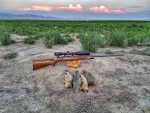 Rifle #1:
Rifle #1:
Kimber of Oregon Model 82M
Vortex Diamondback HP Scope – 4-16x42mm
Bolt-Action – Single Shot
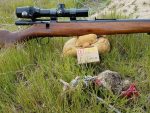 Rifle #2:
Rifle #2:
Winchester Model 43
Bushnell Scopechief VI – 1.5-4.5x20mm
Bolt-Action – 4 round magazine
—–
The Hunts:
As mentioned above, I was able to hunt three states using the Hornady ammunition. Here is a brief description of each hunt (more information is included within the video posted above).
Idaho:
Ten minutes away from my house here in Idaho, is 1000s of acres of BLM land, most of which is loaded with ground squirrels in the spring. After receiving the ammunition, I grabbed my Winchester Model 43 and headed up to sight-in my rifle and maybe get some shots on any ground squirrels hanging around the area I was shooting. When I arrived at my spot, there were ground squirrels EVERYWHERE! I’ve said this in the past, but I shoot paper targets for testing and evaluation, but I mainly shoot targets so I can hunt! Needless to say, I shot a handful of groups, then took the necessary steps to get my rifle dialed in at 100 yards.
As soon as I pulled the trigger on my last group and watched the hole form in the same cluster as the other four I had just shot, I decided that I was sighted-in and ready to kill some critters. I set-up my video camera and microphone on a tripod next to me and found my first target. It was a ground squirrel mound, surrounded by green grass and some old weeds that barely survived the winter. A small group of squirrels were running around the mound, tackling each other and popping in and out of their hole. The one I was eyeing had stopped in front of the mound and was eating the grass. I reached over and tapped the record button on the camera, then found the squirrel again in my scope. I pulled the trigger and watched the squirrel explode in front of my eyes! I gasped a little bit by the amount of red I saw, but I had to smile a bit as well. What a great feeling it was to shoot factory .218 Bee ammo again! Adding to my smile, was the performance of the HP Bee bullet on a ground squirrel not much bigger than half a water bottle. That little bullet completely opened up on impact and launched the squirrel parts everywhere around the mound. This was a good thing, because after the shot, the other ground squirrels started gorging themselves on the guts and body parts that were strewn about.
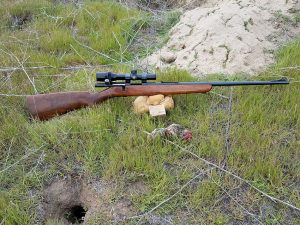 I spent the next hour shooting dozens of ground squirrels and getting a lot of the shots on video! My Model 43 was working flawlessly and my hit percentage was staying in the 80% range. We (my rifle and I) were on fire! As it came time to end the shooting and start packing up, I began taking my camera and tripod apart to pack them away, when I was horrified! In the excitement of shooting, I had forgotten to turn on my Rode microphone. I was very perturbed with myself and when I reviewed the footage later, I realized that it would not be usable. Not a problem, because in the coming months, I knew I had two more states to hunt and a cameraman that would make sure we got the shots on video.
I spent the next hour shooting dozens of ground squirrels and getting a lot of the shots on video! My Model 43 was working flawlessly and my hit percentage was staying in the 80% range. We (my rifle and I) were on fire! As it came time to end the shooting and start packing up, I began taking my camera and tripod apart to pack them away, when I was horrified! In the excitement of shooting, I had forgotten to turn on my Rode microphone. I was very perturbed with myself and when I reviewed the footage later, I realized that it would not be usable. Not a problem, because in the coming months, I knew I had two more states to hunt and a cameraman that would make sure we got the shots on video.
Arizona:
Towards fall, we packed up and headed to Northern Arizona for our prairie dog hunt. I would be using the Winchester Model 43 again, but the shots would be on much larger varmints than the ground squirrels I was shooting in Idaho. My experience told me that the bullets would perform even better on these larger varmints, but I was still eager to see the actual results play out when I pulled the trigger.
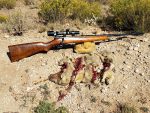 Morning number one was spent in a small valley, loaded with bushes that had sprung up thick and green after the summer Monsoon season. We were spotting prairie dogs through-out these bushes, while they ate as much as they could before winter forced them into their dens. The opportunities were numerous, so we set-up and starting shooting/filming. As expected, this new ammo absolutely blew-up the larger prairie dogs! I was watching them turn inside-out right before my eyes, with every shot being a clean, quick, kill (it’s what we strive for when varmint hunting). After shooting enough video for our needs, I switched over to another rifle/cartridge, but all during the hunt I kept thinking about how well these new Hornady rounds performed on the prairie dogs I shot. I was impressed!
Morning number one was spent in a small valley, loaded with bushes that had sprung up thick and green after the summer Monsoon season. We were spotting prairie dogs through-out these bushes, while they ate as much as they could before winter forced them into their dens. The opportunities were numerous, so we set-up and starting shooting/filming. As expected, this new ammo absolutely blew-up the larger prairie dogs! I was watching them turn inside-out right before my eyes, with every shot being a clean, quick, kill (it’s what we strive for when varmint hunting). After shooting enough video for our needs, I switched over to another rifle/cartridge, but all during the hunt I kept thinking about how well these new Hornady rounds performed on the prairie dogs I shot. I was impressed!
Nevada:
The last hunt trip with the new Hornady .218 Bee ammo was in early spring of 2018. We headed to Northern Nevada to shoot on a ranch that had a major ground squirrel problem. Unlike the smaller ground squirrels we have here in Idaho, this area of Nevada is home to the Belding’s Ground Squirrel. They are much bigger and by late spring, they can be as large as a 9oz water bottle. I have shot 100s of these squirrels, so I knew the results were going to be spectacular.
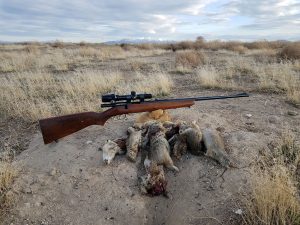 We arrived in the afternoon and got set-up almost immediately. I was shooting my Kimber of Oregon Model 84. The heat had set in, so it was quiet. However, as the afternoon started cooling off a bit, the ground squirrels came out in droves! There were so many targets, CameraMan Tom and I couldn’t keep up on which ones he was videoing and which ones I was shooting! Finally, we settled in on an area that extended out 190 yards to the alfalfa. This gave me the opportunity for shots from 75 yards, all the way out to 190 yards. I decided to focus on everything past 100 yards, with stretching my shots out to the 170-190 yard range. With the mirage, it took me a little bit to get dialed in, but once I did, ground squirrels start blowing up everywhere! It was great shooting and although the video was tinted red (due to the heat), we got some great shots recorded.
We arrived in the afternoon and got set-up almost immediately. I was shooting my Kimber of Oregon Model 84. The heat had set in, so it was quiet. However, as the afternoon started cooling off a bit, the ground squirrels came out in droves! There were so many targets, CameraMan Tom and I couldn’t keep up on which ones he was videoing and which ones I was shooting! Finally, we settled in on an area that extended out 190 yards to the alfalfa. This gave me the opportunity for shots from 75 yards, all the way out to 190 yards. I decided to focus on everything past 100 yards, with stretching my shots out to the 170-190 yard range. With the mirage, it took me a little bit to get dialed in, but once I did, ground squirrels start blowing up everywhere! It was great shooting and although the video was tinted red (due to the heat), we got some great shots recorded.
Final Thoughts:
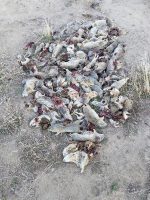 The Hornady .218 Bee ammunition performed very well for me, both on paper and in the field on live targets. It brought back every memory I had about the .218 Bee, but most of all, the feeling of shooting a fun round. Don’t get me wrong, I love the modern cartridges that are out today. But, there is something about shooting a classic cartridge, out of a couple of older rifles, that can’t be equaled. There were no bells and whistles, no fancy triggers, or actions, just a pair of rifles that could shoot this old round.
The Hornady .218 Bee ammunition performed very well for me, both on paper and in the field on live targets. It brought back every memory I had about the .218 Bee, but most of all, the feeling of shooting a fun round. Don’t get me wrong, I love the modern cartridges that are out today. But, there is something about shooting a classic cartridge, out of a couple of older rifles, that can’t be equaled. There were no bells and whistles, no fancy triggers, or actions, just a pair of rifles that could shoot this old round.
My Winchester Model 43 is around 65 years old! I wonder if the original owner ever thought that someone in 2018 would be shooting their rifle, with new factory ammunition from a company started by a guy named Joyce Hornady, who sold his bullets by posting little ads in the shooting magazines that were mailed to his home? If you ever get a chance to shoot a classic caliber, in a classic rifle, do it! You will get to see how far varmint hunting has come, but most importantly, you will get to experience how those Varminters who came before us did it. It’s like a time-machine, but with a bronzed action, an old wood stock and a barrel that’s history is recorded with dings to its bluing.
- Podcast with Soul Seekers Nation From the 2025 SHOT Show - February 17, 2025
- Complete Overview of the .17-5.56 KAK Cartridge by KAK Industry - July 21, 2024
- AGM Global Announces New and Upgraded Optics at the 2024 SHOT Show - February 1, 2024

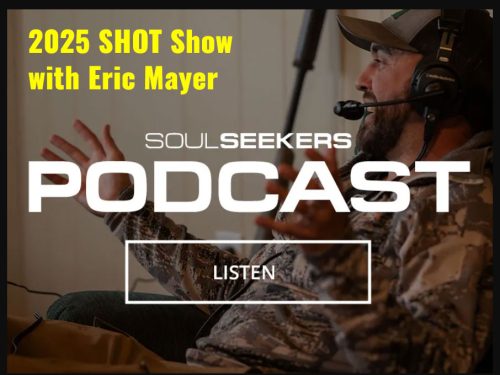
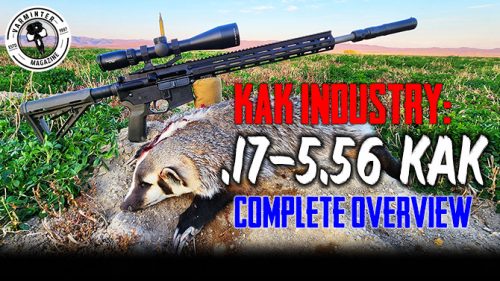
Leave a Reply
You must be logged in to post a comment